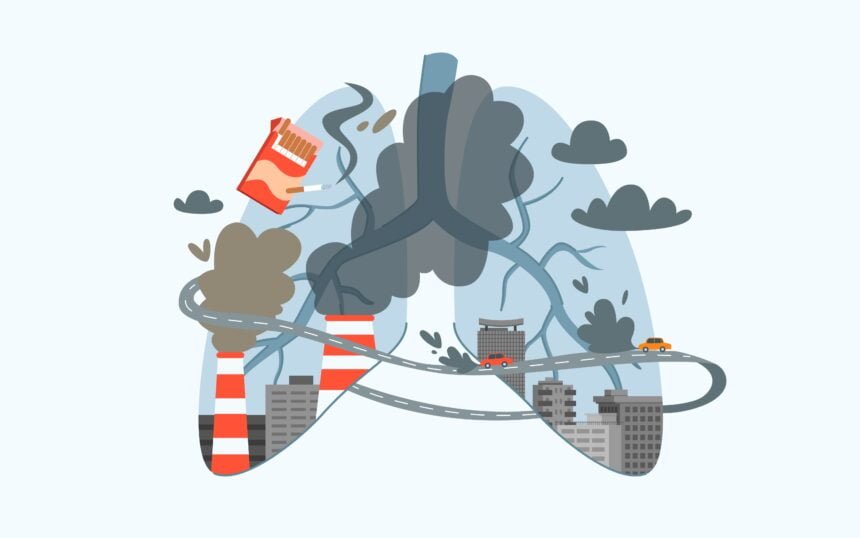We all want to live somewhere that is safe and doesn’t harm our health. However, with the UK being heavily urbanised, many homes are nevertheless located close to areas hit by air pollution. For years – centuries even – air pollution has been viewed as detrimental to human health, and in recent years has been in the spotlight further as the UK experienced a 39% rise in cancer incidence between 2002 and 2022.
Can air pollution cause cancer? In this article, we examine some of the newest research into the topic to find an answer.
Research: Evidence of Links Between Air Pollution and Cancer
Air pollution is linked to a variety of health issues, from respiratory illnesses to heart disease. But recently, research has found that there is a direct correlation between air pollution and cancer. The evidence for the link between the two is so strong that it’s now considered impossible to ignore.
A study conducted by ESMO in 2022 looked at data from nine cities across Europe and Asia-Pacific, which revealed that exposure to air pollutants over a long period of time significantly increases the risk of developing certain types of cancer, including lung cancer and bladder cancer. Furthermore, people who were exposed to higher levels of air pollution were more likely to develop these cancers than those who lived in areas with lower levels of air pollution. This finding was consistent across all cities studied in the study.
What pollution can cause lung cancer?
According to work by the World Health Organisation, the International Agency for Research on Cancer, and a Global Review by the Forum of International Respiratory Societies’ Environmental Committee, air pollution is a key cause of premature death and diseases including cancer.
These global bodies of experts have shown a prominent link between air pollution and cancerous illnesses, particularly regarding PM 2.5 – tiny particles of polluting dust, chemicals, or droplets in the air that are two and a half microns in width.
These particles, primarily formed during the combustion of fossil fuels, are small enough to enter human organs via the lungs and circulatory system. There, they cause a range of diseases, cancer of the lungs being a prominent type.
PM 2.5 affects everyone the same – not just smokers
Up until recently, it was thought that most sufferers of lung cancer were smokers, but research funded by Cancer Research UK has found that even people who don’t smoke can be affected – and it’s all down to PM 2.5.
The research looked at 400,000 people from the UK and countries in Asia and found that outdoor air pollution was the cause of around 10% of all lunch cancer cases each year, 6,000 in all. The researchers stated that, globally, this equated to some 300,000 lung cancer deaths attributed to PM 2.5 in 2019.
What can be done about PM 2.5?
Researchers across the globe are urging governments to regulate air pollution in cities. These sorts of pollution control measures include air treatment systems for industrial facilities that scrub fine particulate matter from exhaust flows, protecting the health of people living nearby, as well as rethinking urban transport networks so they are cleaner and greener.
Reducing private car use, investing in electric public transport systems, and encouraging bicycling and walking are just some of the ways that the cities of tomorrow can become less polluted and healthier for residents.
What do you think policymakers and industry leaders should do to tackle PM 2.5 and reduce the risk of cancer from air pollution? Let us know your thoughts and opinions in the comments section below.
Conclusion: Summary & Actionable Takeaways
Air pollution has long been a topic of concern, but the connections between air pollution and cancer have only recently come to light. There is now a substantial body of research that links air pollution to various forms of cancer such as lung cancer, bladder cancer, breast and kidney cancers. Studies suggest that exposure to pollutants from vehicle exhausts and industrial operations can increase one’s risk for developing these conditions.
The most important takeaway from this article is that it’s essential to take proactive steps in order to protect ourselves from the dangers associated with air pollution. We must work together on both local and global levels to reduce emissions and improve air quality. This may involve adopting more sustainable practices such as using renewable energy sources or taking public transportation instead of driving our own cars. Additionally, individuals should limit their own exposure by avoiding areas with high levels of air pollution if possible.

